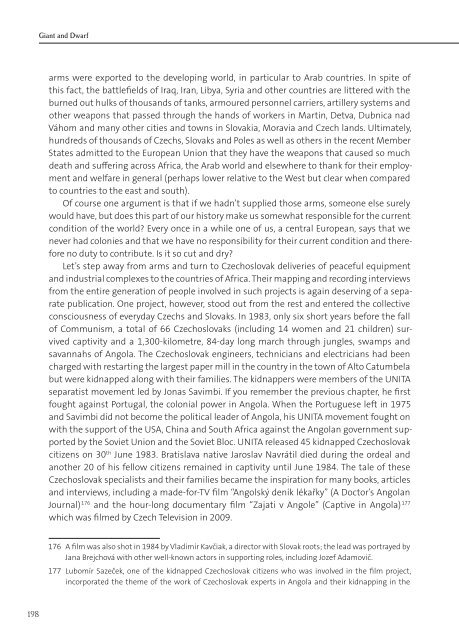Giant_and_Dwarf-FIN
Giant_and_Dwarf-FIN
Giant_and_Dwarf-FIN
Create successful ePaper yourself
Turn your PDF publications into a flip-book with our unique Google optimized e-Paper software.
<strong>Giant</strong> <strong>and</strong> <strong>Dwarf</strong>arms were exported to the developing world, in particular to Arab countries. In spite ofthis fact, the battlefields of Iraq, Iran, Libya, Syria <strong>and</strong> other countries are littered with theburned out hulks of thous<strong>and</strong>s of tanks, armoured personnel carriers, artillery systems <strong>and</strong>other weapons that passed through the h<strong>and</strong>s of workers in Martin, Detva, Dubnica nadVáhom <strong>and</strong> many other cities <strong>and</strong> towns in Slovakia, Moravia <strong>and</strong> Czech l<strong>and</strong>s. Ultimately,hundreds of thous<strong>and</strong>s of Czechs, Slovaks <strong>and</strong> Poles as well as others in the recent MemberStates admitted to the European Union that they have the weapons that caused so muchdeath <strong>and</strong> suffering across Africa, the Arab world <strong>and</strong> elsewhere to thank for their employment<strong>and</strong> welfare in general (perhaps lower relative to the West but clear when comparedto countries to the east <strong>and</strong> south).Of course one argument is that if we hadn’t supplied those arms, someone else surelywould have, but does this part of our history make us somewhat responsible for the currentcondition of the world? Every once in a while one of us, a central European, says that wenever had colonies <strong>and</strong> that we have no responsibility for their current condition <strong>and</strong> thereforeno duty to contribute. Is it so cut <strong>and</strong> dry?Let’s step away from arms <strong>and</strong> turn to Czechoslovak deliveries of peaceful equipment<strong>and</strong> industrial complexes to the countries of Africa. Their mapping <strong>and</strong> recording interviewsfrom the entire generation of people involved in such projects is again deserving of a separatepublication. One project, however, stood out from the rest <strong>and</strong> entered the collectiveconsciousness of everyday Czechs <strong>and</strong> Slovaks. In 1983, only six short years before the fallof Communism, a total of 66 Czechoslovaks (including 14 women <strong>and</strong> 21 children) survivedcaptivity <strong>and</strong> a 1,300-kilometre, 84-day long march through jungles, swamps <strong>and</strong>savannahs of Angola. The Czechoslovak engineers, technicians <strong>and</strong> electricians had beencharged with restarting the largest paper mill in the country in the town of Alto Catumbelabut were kidnapped along with their families. The kidnappers were members of the UNITAseparatist movement led by Jonas Savimbi. If you remember the previous chapter, he firstfought against Portugal, the colonial power in Angola. When the Portuguese left in 1975<strong>and</strong> Savimbi did not become the political leader of Angola, his UNITA movement fought onwith the support of the USA, China <strong>and</strong> South Africa against the Angolan government supportedby the Soviet Union <strong>and</strong> the Soviet Bloc. UNITA released 45 kidnapped Czechoslovakcitizens on 30 th June 1983. Bratislava native Jaroslav Navrátil died during the ordeal <strong>and</strong>another 20 of his fellow citizens remained in captivity until June 1984. The tale of theseCzechoslovak specialists <strong>and</strong> their families became the inspiration for many books, articles<strong>and</strong> interviews, including a made-for-TV film “Angolský deník lékařky” (A Doctor’s AngolanJournal) 176 <strong>and</strong> the hour-long documentary film “Zajati v Angole” (Captive in Angola) 177which was filmed by Czech Television in 2009.176 A film was also shot in 1984 by Vladimír Kavčiak, a director with Slovak roots; the lead was portrayed byJana Brejchová with other well-known actors in supporting roles, including Jozef Adamovič.177 Lubomír Sazeček, one of the kidnapped Czechoslovak citizens who was involved in the film project,incorporated the theme of the work of Czechoslovak experts in Angola <strong>and</strong> their kidnapping in the198


